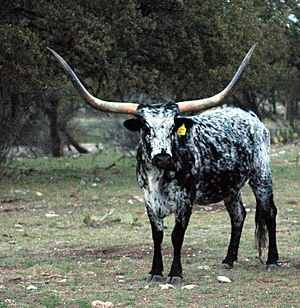Texas Longhorn facts for kids
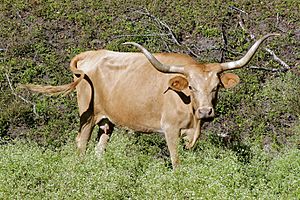 |
|
| Conservation status |
|
|---|---|
| Country of origin | United States |
| Traits | |
| Coat | red, white, black, brown |
| Horn status | horned, large thick horns |
|
|
The Texas Longhorn is a special type of cattle from America. It is famous for its very long horns. These horns can stretch more than 8 feet (2.4 meters) from one tip to the other!
These cattle first came to the Americas with Spanish explorers like Christopher Columbus around 1493. For hundreds of years, they lived wild on open lands. This helped them become very tough. They can handle hot weather and dry conditions much better than many other cattle breeds.
Texas Longhorns can be almost any color or mix of colors. About 40% of them are some shade of red, often a light red. Today, the Texas Longhorn is an important part of the history and culture of Texas.
Contents
History of Texas Longhorns
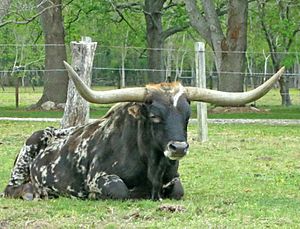
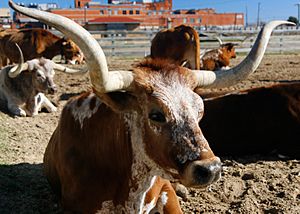
The story of the Texas Longhorn began when Spanish explorers brought cattle to the Americas. This started with Columbus's second trip in 1493. The first cattle landed on an island called Hispaniola in the Caribbean. They were meant to provide food for the new settlers.
Over the next 200 years, the Spanish moved these cattle into Mexico. As they expanded their settlements, the cattle moved north with them. By the late 1600s, they reached the area we now call Texas.
Many of these cattle escaped or were set free on the wide-open lands. They lived wild for about 200 years. During this time, they became very strong and hardy. They learned to survive with little food and water. This is why Longhorns are known for being tough animals.
Saving the Breed
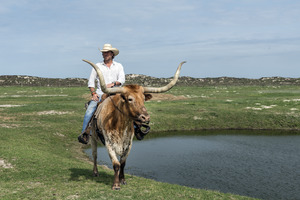
Over time, the number of Texas Longhorns started to drop. But in 1927, some people from the United States Forest Service helped save them. They gathered a small group of Longhorns to breed them at the Wichita Mountains Wildlife Refuge in Oklahoma.
The breed also became very popular when a Longhorn named "Bevo" became the mascot for The University of Texas at Austin in 1917. Bevo's image became a symbol for the school's sports teams, the Texas Longhorns.
Later, a writer named J. Frank Dobie and others collected more small herds. They kept these herds in Texas state parks. An oilman named Sid W. Richardson helped pay for this project. At first, people kept Longhorns mostly as interesting animals. But their long lives, ability to resist sickness, and skill at living on poor land made them popular again for beef and as a link to Texas history.
Modern Longhorn History
In 1957, Charles Schreiner III started his own Longhorn herd on his ranch in Texas. He wanted to honor his grandfather's ranching history. In 1964, Schreiner started the Texas Longhorn Breeders Association of America. His ranch's cattle were the first to be officially registered with this group.
To make the Longhorn and the new association famous, Schreiner organized a cattle drive in 1966. He moved Longhorn steers from San Antonio, Texas, to Dodge City, Kansas. This drive celebrated the old Chisholm Trail drives from 100 years before.
In 1995, the Texas government officially named the Texas Longhorn as the state's large mammal. Today, some Texas Longhorns from special family lines can sell for a lot of money at auctions.
There are several groups that keep records of Texas Longhorn cattle. These include the Texas Longhorn Breeders Association of America and the International Texas Longhorn Association. There is also an online museum that shows the amazing variety of horns these cattle have.
What Makes Longhorns Special?
Texas Longhorns are related to cattle breeds from Spain and Portugal. They are mostly European cattle, but they have a small bit of African cattle in their genes too. This might have happened long ago when cattle crossed the Strait of Gibraltar.
Horns and Colors
The horns of Texas Longhorns can be incredibly long. Male Longhorns (bulls) usually have horns of medium length. But steers (male cattle that cannot reproduce) can have much longer horns. In 2022, the Guinness Book of Records listed three Texas Longhorns for having the longest horns:
- A steer named Poncho Via had horns that spread over 323.7 cm (about 10.6 feet).
- A cow named 3S Danica had horns that spread over 265.1 cm (about 8.7 feet).
- A bull named Cowboy Tuff Chex had horns that spread over 262.5 cm (about 8.6 feet).
Longhorns come in many different colors. About 40% are some shade of red, usually a light red. They can also be black, blue, brown, cream, gray, yellow, or white. Their coats can have stripes (called brindling), speckles, or spots.
How Longhorns Are Used
Texas Longhorns were traditionally raised for their beef. Today, they are also seen as an important part of Texas's history and culture. They are the official large mammal of the state.
Sometimes, Longhorns are kept for conservation reasons to protect the breed. People also breed them to get even longer horns. You might even see them used for steer riding at some events.
See also
 In Spanish: Texas Longhorn (raza bovina) para niños
In Spanish: Texas Longhorn (raza bovina) para niños


